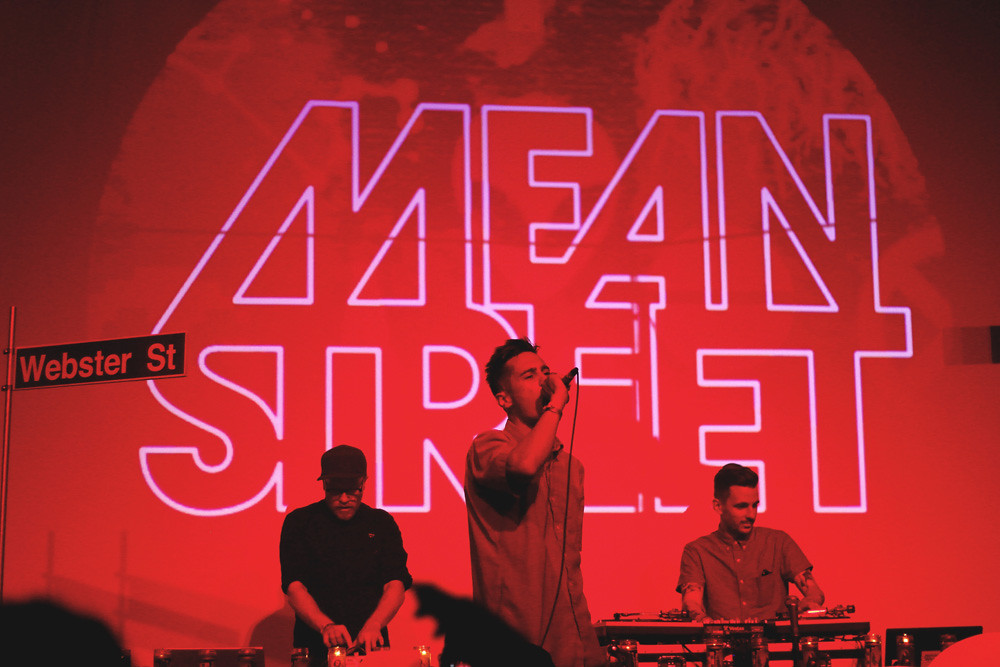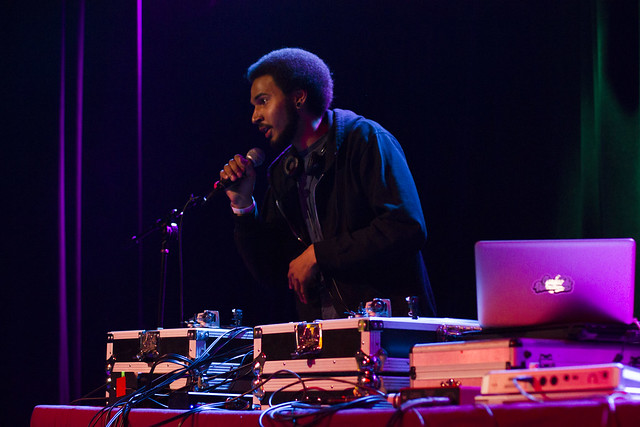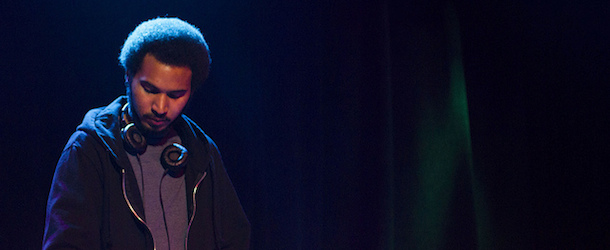We can conceive how Monet began his “Water Lilies.”
We can imagine him dragging the first brushstroke across a large, white canvas. We can picture Michelangelo sizing up the block of marble from which “David” will be carved. Figuring out how these masterpieces were put together, and envisioning these masters completing these great works is part of what fascinates us about art.
This is also why collage puzzles us. The overlapping of once foreign mediums and works of various stages of completion makes it difficult to decipher where the larger piece truly began. Initially, one imagines the process as haphazard. Intersections, cross-references and juxtapositions are as important as composition, and can confuse or distract, as well as deepen, the larger meaning of the work.
Collage is a sum of many identifiable parts that, when separate, do not always make complete sense, but are harmonious when tied together by the artist’s hand.
Hip-hop music is auditory collage.
It has been an aspect of hip-hop culture since its birth. In the early days of turntablism, when DJs would “cut” quotes from other emcees and artists into mixes and songs: hip-hop artists have always been sampling more than music.
It is, in a sense, one of the many aspects that made hip-hop revolutionary. It is the culture that introduced postmodernity to a generation of American popular culture by recycling and repurposing principles, iconography and aesthetics once reserved to their own respective contexts. It democratized American culture, revealing its inherent oppressive nature by those disenfranchised, simply by their re-appropriation of it. As Motown, the epicenter of Black and American culture for decades began to sink along with the systematic destruction of Detroit, communities in the projects of Brooklyn, now without the disposable income to buy instruments, brought about the next musical renaissance using what they had, records and turntables.
Public Enemy could quote revolutionaries while sitting on the Billboard charts, forcing bridges between segregated genres and cultures. The Wu Tang Clan could bring the temples of Shaolin to Staten Island. De La Soul could shoot some ‘60s pop band up to Mars and in a one minute-long song, set the music industry on fire.
* * *
By using samples to convey their own emotions and ideas, the Omaha hip-hop group M34N STR33T follows in that tradition. The trio was formed by emcee Conchance, aka Conny Franko, DJ Really Real, and producer and beatmaker Haunted Gauntlet. Mutants of Omaha, their most recent release, samples from film, television, old-school soul music, rock and electronic dance elements within a hip-hop context.
M34N STR33T’s sound pulls from vinyl to YouTube or Netflix.
“[It’s] basically anything and everything that inspires us with no rules, or boundaries,” says Haunted Gauntlet aka Adam Haug. “Then it is arranged and backed with live instruments and audio production to pull it all together for more of a modern 2014 sound/mix.”
Gangster films, for one, have been infused into hip-hop music for decades: from Scarface, Goodfellas, Carlito’s Way, Nino Brown, and Jay Z even made an entire album of the same name paired with American Gangster (and DJ Skee made an American Godfather remix album soon after). In these cases, quotes and references from the film were used by artists to align themselves to fictional mobsters, and add a cinematic dimension to the music.
Though the group’s namesake is very similar to Martin Scorsese’s film Mean Streets, the Omaha outfit wasn’t initially inspired by the gangster film. Originally, the band’s name alluded to the mathematical mean and the golden mean, as a reference to art.
Adam Haug, who hadn’t seen Mean Streets until after forming the group, gravitated to the film for other reasons.
“Although the film was made in 1973, it felt very relevant to present times,” Haug says. “I related closely to the themes about spirituality/religion or lack there of, mischief and right living, city life/bar life and the underground side of a city. On top of all that there is a killer oldies soundtrack, great cinematography, acting/dialogue.”

photo by Chris Dinan
Mean Streets wasn’t the only film referenced by the group on Mutants of Omaha. The album’s first track, “M34N OLD WORLD” begins by quoting Planet of the Apes, a film that imagines a world where all men are mutants. The furious opener, driven by hard-hitting drums and aggressive scratching from Really Real, dips into a breakdown sampling Marion Williams’ gospel tune “Mean Old World”, and ends on a similar spiritual note with Harvey Keitel’s famous scene in Mean Streets where his character, Charlie, ponders hellfire and spiritual pain.
Haug watches plenty of film and television with an ear open for just the right sections to pull. Aside for hunting for hidden gems, Haug tries to find a connection between each sample he finds.
“A lot of it is pretty terrible, but you will find moments that are pure gold essence, and that is what I am looking for,” Haug says. “You find one element and that gets you searching for the next link in the chain. Typically, adding samples is like the cherry on top and we will have DJ Really Real scratch them up nicely into the track in a way more akin to the way rap/hip-hop genre uses samples on top of beats.”
Haug’s process of searching for samples that link together is similar to that of MF DOOM, a popular emcee/producer who is known for sampling television and film, particularly on his album Mm.. Food. The album samples old television cartoons, especially segments that feature the Marvel villain Doom.
“Sometimes months of gathering pieces— sometimes I leave it alone for few months, and come back to that one piece I needed,” he said in a ‘11 Red Bull Academy interview. “At first the piece is telling me the story. I find one or two things … then it will start telling me more and more.”
DOOM, an artist who tipped an entire generation off to sampling film and television, was inspired by The Zulu Beat Show, a 1980s late-night radio show in New Jersey he listened to when he was a kid. DJ Afrika Islam would interplay clips from spaghetti westerns to Monty Python sketches between “Planet Rock” and Grandmaster Flash and the Furious Five.
The process of using and finding samples is often impulsive, instinctive and flexible.
“It’s definitely experimental, non-format, not structural,” says Dojorok, a producer and DJ based in Omaha who has produced tracks for Conchance and sits on the production and DJ half of Midtown Marauders. “You start with one thing, and see where it goes, and compound ideas on top of that.”
“I think people should have a guttural reaction,” says Keith Rodger, aka Kethro, a producer and DJ, also from Omaha. “When you’re creating music, I don’t think you should try to put too much thought into what you are listening to. Personally, I like to keep an open mind. If something you hear just hits you in a way that something else doesn’t that’s a good feeling and you should take that route.”

photo of Kethro by Molly Misek
Dojorok often draws from Westerns for nostalgia’s sake.
“I kind of stick to things I grew up on,” he says. “I used to watch a lot of old Western movies when I was young, like Ennio Morricone soundtracks, so I sampled a bunch from both the music and monologues. I have a bunch of Bruce Lee stuff I sample, too.”
Haug, who is currently working on a M34N STR33T track (slated for release this summer) that samples Mexican drama Y Tu Mamá También, has a penchant for foreign films as well.
Rodger also looks to Spanish film, as well as French and classic Japanese films, as sampling source material.
“I like foreign films because English-speaking people won’t really ever understand what they are saying, but I feel like whatever element I am taking from the film, whether it be a song, the voices, or just the sound effects from the film itself are a little different,” he says.
Rodger was introduced to the possibilities of sampling through the work of one of his favorite artists, LA producer Madlib, who has sampled Indian Bollywood film as often as he samples Blaxploitation flicks.
“I truly admired [Madlib’s work] because it taught me there was no limit to what you could sample or what you could to make music,” Kethro says. “I think [his music] mainly based on the feel- it doesn’t matter where it comes from, as long as it sounds good.”
Rodger pulls from whatever inspires him, the moment it does, wherever he is. In fact, one of the reasons why he bought an MPC, a sampling machine, was so that he could sample television. He hooks up the machine to the television just to catch interesting news broadcasts or commercials.
Rodger sets entire days off just to do this to focus on exploration and discovery rather than creation. “I have these personal days I call sampling days where I don’t make any music,” Rodger says. “I don’t write anything, I just listen to records, watch TV or movies, and whatever I think would be cool, I make a fragment of it and go away.”
He stores and catalogues all these samples in a digital library of his so he can use them at a later time for beats and for his DJ sets. Rodger doesn’t set off looking for anything in mind. “I just sample whatever comes,” he says.
And inspiration can come from anywhere; inspiration knows no bounds. Monet, one of the greatest Impressionists, was influenced by the ordinary, everyday subjects of the Realists before him. Even still, painters aren’t influenced by works solely on the canvas. Picasso was influenced by African sculpture. Great artists aren’t confined to one medium; Michelangelo worked with charcoal, frescos, and was an architect.
* * *
Sampling reaches far beyond music and film. It doesn’t stop at hip-hop, either.
Crate diggers, producers who sift through old records to find samples, hunt for rare soul and funk records, but they look for samples in comedy and spoken word albums, as well. Dojorok came across a sample that serves as a cool nod to his DJ name.
“I have record called Maturity, one of those self-help records of the ‘80s or early ‘90s,” he says. “There are different everyday situations, and one of them happens to be in a karate, or dojo. They interview one of the kids and say, ‘What is a Dojo?’ … It’s pretty rad.”
Dojorok has yet to use the record in one of his beats. He’s been using it in his DJ sets for years, not only during his turntablist scratching sets, but during his Drum & Bass mixes, as well. Dojorok has been a sampling Drum & Bass DJ longer than he’s made beats, only producing hip-hop for the past three years.
produced by Dojorok
Haug was turned onto the sampling of film dialogue by the hardcore and screamo bands he would listen to in the late ‘90s and early 2000s. And Rodger sees himself as a hip-hop and house producer, and doesn’t know which style a track will turn out once he sits down in the studio.
Burial, one of Rodger’s favorite artists who “opened his mind” to new ways to sample, isn’t even a hip-hop artist. He’s a London-based electronic artist who pulls from house, dubstep, garage, and ambient music.
The British artist has said some of his own favorite samples include using Vin Diesel’s car keys in a film and bullet casings hitting concrete in the video game Metal Gear Solid.
“He would have samples that were obvious, from playstation games [song here] and the Alien movies but there are samples from movies they’ve never seen or quotes from people giving speeches, or individual sounds of machines turning on, or chains dropping on the floor,” Rodger says.
That inspired him to look into field recording and sound designers for new sounds and textures to use. He visited factories and plants to record raw mechanical sounds to use in his sets, hip-hop, and house productions, and started seeking out those who create sounds professionally. Some, like Standingwave, share their sounds from projects like Transparent Machine on their SoundCloud.
Rodger hopes to push his work even further by sampling and manipulating sounds.
“I no longer have to rely on music to sample, but I can also find these great sound effects I can use,” Rodger says. “When I come out with an EP, the credentials on the EP won’t just be crediting sampling artists I’ve used but sound designers — everyday dudes that go out with field recorders, recording all kinds of stuff. I’m happy to find those sources and find new ways to express those sounds in a musical format. I think that’s something I’ve been chasing for a while.”
Sampling is a skill and a technique that isn’t limited to genre. Though hip-hop is the common thread that has linked and popularized the technique among fans and artists around the world, the art of sampling, whether it is of film, radio, music, the growl of an engine, or the crashing of waves, sampling is an art unto itself.




